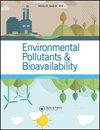Removal of Levofloxacin from aqueous solution by Magnesium-impregnated Biochar: batch and column experiments
Q3 Chemical Engineering
引用次数: 21
Abstract
ABSTRACT Adsorption of levofloxacin (LEV) onto four types of magnesium (Mg)-impregnated biochars, fabricated via thermal pyrolysis of wood chips pretreated with MgSO4 was investigated. The Mg-impregnated biochars were characterized with various tools and techniques. Batch sorption experiments were conducted to determine the sorption kinetics and isotherms of LEV onto the Mg-impregnated biochars. The pseudo-second order kinetic model described the adsorption kinetic data better than the pseudo-first order kinetic model and the Elovich equation. Due to multi-mechanisms, the Freundlich model described the experimental isotherms better than the Langmuir model. The Langmuir maximum adsorption capacities of the Mg-impregnated biochars to LEV ranged from 7.38 to 25.2 mg g−1. In the fixed-bed column experiment, higher bed height and lower flow rate led to greater LEV removal. Findings from this work indicate that Mg-impregnated biochars can be used as an alternative adsorbent to effectively remove LEV from aqueous solutions.镁浸渍生物炭去除水溶液中的左氧氟沙星:间歇和柱式实验
研究了用热裂解法制备的四种镁浸渍生物炭对左氧氟沙星的吸附性能。利用各种工具和技术对镁浸渍生物炭进行了表征。进行了分批吸附实验,以确定LEV在镁浸渍生物炭上的吸附动力学和等温线。拟二阶动力学模型比拟一阶动力学模型和Elovich方程更好地描述了吸附动力学数据。由于多种机理,Freundlich模型比Langmuir模型更好地描述了实验等温线。浸镁生物炭对LEV的Langmuir最大吸附容量为7.38~25.2mg g−1。在固定床柱实验中,较高的床高和较低的流速导致较高的LEV去除率。这项工作的结果表明,浸渍镁的生物炭可以作为一种替代吸附剂,有效地去除水溶液中的LEV。
本文章由计算机程序翻译,如有差异,请以英文原文为准。
求助全文
约1分钟内获得全文
求助全文
来源期刊
CiteScore
1.62
自引率
0.00%
发文量
0
审稿时长
1 months
期刊介绍:
Chemical Speciation & Bioavailability ( CS&B) is a scholarly, peer-reviewed forum for insights on the chemical aspects of occurrence, distribution, transport, transformation, transfer, fate, and effects of substances in the environment and biota, and their impacts on the uptake of the substances by living organisms. Substances of interests include both beneficial and toxic ones, especially nutrients, heavy metals, persistent organic pollutants, and emerging contaminants, such as engineered nanomaterials, as well as pharmaceuticals and personal-care products as pollutants. It is the aim of this Journal to develop an international community of experienced colleagues to promote the research, discussion, review, and spread of information on chemical speciation and bioavailability, which is a topic of interest to researchers in many disciplines, including environmental, chemical, biological, food, medical, toxicology, and health sciences.
Key themes in the scope of the Journal include, but are not limited to, the following “6Ms”:
Methods for speciation analysis and the evaluation of bioavailability, especially the development, validation, and application of novel methods and techniques.
Media that sustain the processes of release, distribution, transformation, and transfer of chemical speciation; of particular interest are emerging contaminants, such as engineered nanomaterials, pharmaceuticals, and personal-care products.
Mobility of substance species in environment and biota, either spatially or temporally.
Matters that influence the chemical speciation and bioavailability, mainly environmentally relevant conditions.
Mechanisms that govern the transport, transformation, transfer, and fate of chemical speciation in the environment, and the biouptake of substances.
Models for the simulation of chemical speciation and bioavailability, and for the prediction of toxicity.
Chemical Speciation & Bioavailability is a fully open access journal. This means all submitted articles will, if accepted, be available for anyone to read, anywhere, at any time. immediately on publication. There are no charges for submission to this journal.

 求助内容:
求助内容: 应助结果提醒方式:
应助结果提醒方式:


